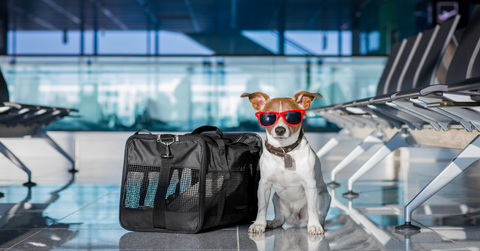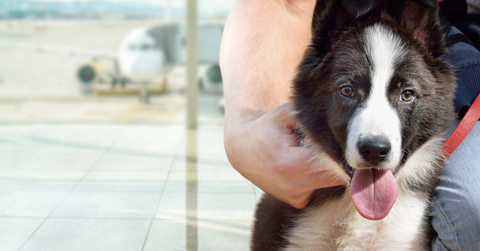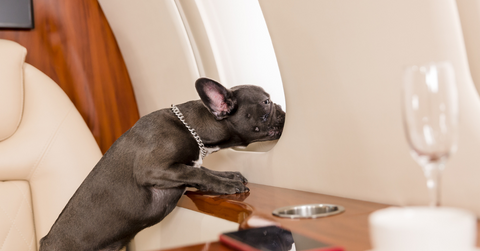How to Fly with a Large Dog: Tips and Tricks
Traveling can be challenging, especially when it involves flying with a large dog. Whether your furry friend is a service dog, therapy dog, or simply a beloved pet, understanding the guidelines set by most airlines is crucial.
Many airlines have specific policies for live animals, including those for emotional support animals and dogs traveling as checked baggage. From domestic flights to international journeys, learn how to navigate the skies with your large companion, ensuring a smooth and stress-free trip for both of you.
In this blog, we'll share some insights on how to make flying with your dog smooth and stress-free. We aim to ensure your next journey with your large dog is as comfortable and hassle-free as possible for you and your live animal companion.
Preparing Your Large Dog for Air Travel
Airline policies for large dogs can vary significantly, depending on the airline, the specific flight, and the country of origin or destination. Here are general guidelines and factors to consider if you're planning to travel with a large dog:
Cabin vs. Cargo
Most airlines allow small pets to travel in the cabin with their owners, provided they can fit in a carrier under the seat. However, large dogs are usually required to travel in the cargo hold, placed in a pressurized and temperature-controlled environment.
Health and Vaccination Requirements
Airlines require health certificates from a veterinarian, usually obtained within 10 days before travel. Vaccination requirements, particularly for rabies, can vary by destination.
Crate Requirements
Airlines have strict regulations on crate size and type for dogs traveling in cargo. The crate must be large enough for the dog to stand, turn around, and lie down comfortably, and it must also be IATA (International Air Transport Association) compliant.
Temperature Restrictions
Due to potential health risks from extreme temperatures in the cargo hold, airlines may restrict pet transport during hot or cold weather.
Advance Arrangements
Most airlines have limited space for pets or cargo in the cabin, so making arrangements well in advance is essential. There might also be additional fees and paperwork involved.
International Travel
If you're traveling internationally, be aware that countries sometimes have their import regulations for pets, including quarantine requirements. Researching and fulfilling these requirements well ahead of your travel dates is necessary.
Service and Emotional Support Animals
Regulations for service dogs (those trained to perform tasks for individuals with disabilities) can differ from those for pets. Emotional support animals, which used to be more broadly accepted, are now more restricted in their acceptance on many airlines following new regulations.
Packing Essentials for Your Large Dog's Flight

Ready to pack? Packaging smart can make your journey smoother, from ensuring your dog’s crate is well-stocked to carrying essential items in your carry-on luggage.
- Approved Pet Carrier: Airlines have specific requirements for travel crates, often based on the International Air Transport Association (IATA) regulations. The crate should have enough room for your dog to stand, turn around, and lie comfortably. It should also be secure and well-ventilated.
- Crate Labeling and Identification: Label the crate with your contact information, your dog’s name, and a photo of your dog. Attach a travel water bottle or a dish for water and food that attaches to the crate door. It’s also a good idea to include a familiar item, like a blanket or a toy, to comfort your dog.
- Leash and Collar with ID Tags: Even though your dog will be in a crate, having a leash and collar with up-to-date ID tags is essential for when they're out of the crate.
- Food and Water: Pack enough food for the journey and a little extra in case of delays. Include a water bottle or portable bowl for hydration. Familiar food and treats can also help soothe travel anxiety.
- Medications and First-Aid Kit: If your dog is on any medication, ensure you have enough for your trip, plus some extra. A basic pet first-aid kit is also a good idea.
- Comfort Items: Items that smell like home, such as a blanket or a favorite toy, can help reduce stress and make the crate feel more comforting.
- Potty Pads and Cleaning Supplies: Accidents happen, especially during long flights. Absorbent potty pads at the bottom of the crate and cleaning supplies like disposable gloves and bags will help manage any messes.
At the Airport: Checking In and Security Procedures
Both check-in and security procedures at the airport require some extra steps to ensure the safety and comfort of your pet and compliance with airline and airport regulations.
Checking In Your Large Dog
Checking in your dog involves arriving early and providing the necessary documentation. Remember, the procedures are different for domestic and international flights.
Security Screening for Larger Dogs
Security screening can be a breeze if you know what to expect. Your dog must be removed from its carriers and walked through security on a leash.
Locating Pet Relief Areas
Need a pet-relief break? Many airports offer pet relief areas to ensure your dog can relieve themselves before and after the flight.
Ensuring Comfort and Safety During the Flight

Once you're flying, keeping your dog safe and comfortable is crucial. Paying attention to the cargo hold's temperature and air pressure and ensuring your dog stays hydrated and fed is essential.
Managing Temperature and Air Pressure in the Cargo Hold
Your dog’s safety and well-being are critical during the flight. Monitoring the temperature and air pressure in the cargo hold can keep them comfortable during the journey.
Hydration and Feeding During the Flight
It is important to keep your dog hydrated and well-fed during the flight. Avoid feeding your dog right before the flight to minimize motion sickness and ensure they have access to water throughout the flight.
Special Considerations for Specific Dog Breeds

Certain breeds require special considerations based on a dog’s size. From breed-specific airline restrictions to preparing brachycephalic (snub-nosed) dogs for flight, a little knowledge goes a long way when traveling with a large dog internationally.
Breed-Specific Airline Restrictions
Breed-specific restrictions can impact your dog’s travel options. Certain breeds might require additional documentation or special arrangements.
Preparing Brachycephalic (Snub-Nosed) Dogs for Flight
Preparing snub-nosed dogs for a flight requires a unique approach. Understanding their health risks and ensuring proper crate size, temperature management, and hydration can ensure a safe journey.
Aim for a Stress-Free Air Travel with Your Large Dog
With the right preparation and knowledge, flying with a large dog can be a manageable and stress-free experience. The tips above can help pet owners ensure a smooth journey for themselves and their furry companions.
Furthermore, investing in high-quality essentials from trusted brands at Petmate can significantly enhance the comfort and safety of large dogs during air travel. Whether it's a sturdy travel crate, a reliable pet carrier, or other accessories, having the right gear is crucial.
Pet owners should plan and be informed about the process, which can make all the difference in ensuring a positive experience for you and your beloved pup. So, shop for the best products and fly confidently, knowing you've taken the necessary steps to make the journey as comfortable and safe as possible for your large dog.
Previous article

Next article

Related posts
View all-

What Can You Use Instead of Cat Litter?
Traditional cat litter is convenient, but it’s not the only option. Many cat owners look for alternatives to reduce waste, save money, or avoid chemicals found in clay-based kitty litter. Some options offer better odor control, while others are more eco-friendly or gentler on a cat’s paws.
Read Article -

How to Keep My Backyard Smelling Fresh
A clean backyard should smell fresh, unlike pet waste, smoke, or mold. Bad smells can linger, especially when dog poop, urine, or food scraps attract flies and bacteria. If your yard has a foul odor, it's time to take action. The first step is cleaning up pet feces, trash, or rotting food. A garden hose can wash away dirt and urine from artificial turf, patios, and decks. To neutralize odor, Use baking soda, white vinegar, and essential oils.
Read Article -

What Supplies Do First-Time Cat Owners Need?
Bringing home a new cat is exciting, but making them feel safe and comfortable takes more than love. First-time cat owners must prepare with the right supplies to ensure a smooth transition. From a litter box to cat food and a warm bed, having the basics ready can help your new kitty settle in faster. This guide covers everything a new cat owner needs to make their new pet feel at home.
Read Article



